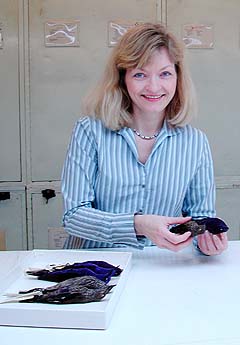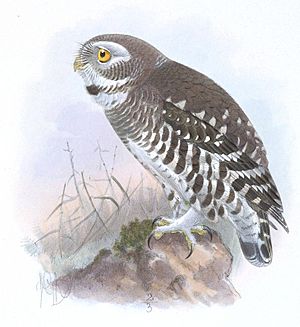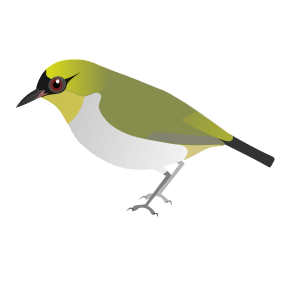Pamela C. Rasmussen facts for kids
Quick facts for kids
Pamela C. Rasmussen
|
|
|---|---|
 |
|
| Born | October 16, 1959 |
| Nationality | American |
| Alma mater | Walla Walla University (MS) University of Kansas (PhD) |
| Scientific career | |
| Fields | Ornithology |
| Institutions | |
Pamela Cecile Rasmussen (born October 16, 1959) is an American ornithologist. This means she is a scientist who studies birds. She is a top expert on birds found in Asia.
Dr. Rasmussen used to work at the Smithsonian Institution in Washington, D.C. Now, she works at Michigan State University. She also works with other big research centers in the United States and the United Kingdom.
Her early studies looked at seabirds in South America and very old bird fossils from North America. Later, she focused on Asian birds. She found and described several new bird species. She also helped understand the true identity of other birds, especially white-eyes and owls.
More recently, she has worked with many other scientists on large projects. These projects look at how different kinds of living things are spread across the world. She also checked the scientific names of South Asian vultures.
Dr. Rasmussen was the main author of Birds of South Asia: The Ripley Guide. This book was very important because it covered more areas and more bird species than earlier books. While working on the book, she studied many bird specimens from museums. This work helped her discover that some old museum records were not real.
Contents
Becoming a Bird Expert
Pamela Rasmussen's interest in birds started when she was young. Her mother bought her a children's book about birds. After that, Pamela always asked for bird books as gifts.
She earned her Master of Science (M.S.) degree in 1983 from Walla Walla University. She then got her Ph.D. (Doctor of Philosophy) in 1990 from the University of Kansas. At Kansas, she studied blue-eyed shags, which are a type of seabird.
Dr. Rasmussen is now a visiting professor of zoology at Michigan State University (MSU). She also helps manage the museum's collections of mammals and birds. Before this, she was a research associate at the Smithsonian Institution.
She is part of many important bird groups. These include the American Ornithological Society (AOS) and the British Natural History Museum. She also helps edit The Ibis, a science journal about birds. Since 2020, she has been an editor for the IOC World Bird List. This is an online list of all the world's birds.
Dr. Rasmussen is married to Michael D. Gottfried. He is a professor and expert in paleontology at MSU.
Discovering New Birds
Dr. Rasmussen's early work focused on Patagonian seabirds, especially cormorants. She studied how their feathers changed as they grew. She also looked at their behavior to understand how different cormorant species are related.
Asian Bird Discoveries
Dr. Rasmussen found and described four new Asian bird species. She did this by carefully studying bird specimens in museums.
- The Nicobar scops owl (Otus alius)
- The Sangihe scops owl (Otus collari)
- The cinnabar hawk owl (Ninox ios) from Sulawesi
- The Taiwan bush-warbler (Bradypterus alishanensis)
She also helped rediscover the forest owlet (Athene blewitti). This owl had not been seen since 1884! Previous searches for it had failed because they used incorrect old records. In November 1997, Dr. Rasmussen and Ben King found the owl in western India. King spotted a small, chunky owl, and Rasmussen confirmed it was the forest owlet. They took videos and photos of it.
With her team, she also helped clear up the scientific names of Indonesian white-eyes. They confirmed that the Sangihe white-eye and the Seram white-eye are separate species. They also confirmed the identity of the Serendib scops owl from Sri Lanka.
In 2008, Dr. Rasmussen and her team officially described the Togian white-eye (Zosterops somadikartai). This bird lives only on the Togian Islands in Indonesia. Unlike most white-eyes, it does not have a white ring around its eye. Dr. Rasmussen noted that its song is also special. It sounds higher pitched and less varied than the songs of its relatives.
Dr. Rasmussen also studied the imperial pheasant. This rare bird lives in the forests of Vietnam and Laos. She and her team used different methods, including DNA analysis. They showed that this pheasant, once thought to be a separate species, is actually a natural mix of two other pheasants.
Helping Vultures
Pamela Rasmussen's interest in Asian birds also led her to work on conservation projects. Two types of vultures in South Asia faced a huge problem. Their populations dropped by 99 percent. This was because they were poisoned by a medicine called diclofenac. This medicine was given to cattle, and it harmed the vultures when they ate the cattle's bodies.
Dr. Rasmussen showed that there are actually two different species of "long-billed vulture." These are the Indian vulture (G. indicus) and the slender-billed vulture (G. tenuirostris). This discovery is very important for conservation. Knowing there are two species helps scientists better plan programs to save these endangered birds.
Understanding Biodiversity
In 2005, Dr. Rasmussen was part of a big project with many institutions. They studied "biodiversity hotspots." These are areas with many different kinds of living things that are important for conservation. The study looked at bird diversity in three ways:
- How many different species live there.
- How threatened those species are.
- How many species live only in that area (endemic species).
The study found that these three factors did not always match up in the same places. This means that different types of hotspots are important for different reasons. This helps scientists decide the best ways to protect different areas.
Dr. Rasmussen's recent work continues to focus on large studies of global biodiversity. One study looked at how many species live in different areas and how big their living spaces are. Another study looked at how human actions affect the risk of species becoming extinct. They found that human impact is the biggest reason for extinction risk.
Other studies by Dr. Rasmussen and her team looked at how much energy is available in different places. They also showed that common species, not just rare ones, play a big role in how biodiversity changes across the Earth. This helps create a better understanding of how living things are spread around the world.
Studying Ancient Birds
Dr. Rasmussen has also studied fossil birds. At a site in Cheswold, Delaware, scientists found pieces of bird fossils. Dr. Rasmussen identified them as a small loon, a small gull-like bird, and five pieces of a gannet-like seabird. These finds suggest that the Delaware site was a bay area long ago.
She also helped review fossil birds from the Miocene and Pliocene periods in North Carolina. These finds included an early Miocene loon and various ducks. They also found a type of tern similar to the modern royal tern. One rare find was a fossil of a crow, which is a type of passerine bird. The review showed that most fossil birds from this time look very much like modern birds.
Birds of South Asia
In 1992, Dr. Rasmussen became an assistant to S. Dillon Ripley. He was planning to write a detailed guide to the birds of South Asia. When he became ill, Dr. Rasmussen took over the project. With artist John C. Anderton, she created Birds of South Asia: The Ripley Guide.
This book has two volumes. It was the first guide for the area to include sonograms, which are pictures of bird sounds. Volume 1 is the field guide with over 3400 illustrations and more than 1450 color maps. Volume 2 gives details about identification, where birds live, and their habits. It also has over 1000 sonograms of bird calls.
The guide covers 1508 bird species found in India, Bangladesh, Pakistan, Nepal, Bhutan, Maldives, the Chagos archipelago, and Afghanistan. A special part of the book is that it used museum specimens to show where birds live. It also changed the scientific names of many species, treating some as full species that were once thought to be just types of the same species.
Some experts have praised the book. However, others have pointed out that some illustrations are small or not quite right. Some also believe that relying only on old museum specimens might miss important information from bird watchers.
During the making of the book, there were challenges. The main map database was lost during a trip. Some bird specimens were not well prepared. There were also difficulties getting good information for certain areas like Assam and Afghanistan.
Dr. Rasmussen considered if the new bird names in the book would greatly affect conservation efforts. She felt that the impact on the number of threatened species in South Asia would be small.
Solving a Bird Mystery
Dr. Rasmussen helped uncover a big problem with old bird records. A famous British ornithologist named Colonel Richard Meinertzhagen had a huge collection of bird specimens. He was considered a great bird expert. However, in the early 1990s, another ornithologist found that some of Meinertzhagen's records were not real.
When Dr. Rasmussen was working on Birds of South Asia, she looked at tens of thousands of bird specimens. She and Robert Prys-Jones found that the problem was much bigger than first thought. Many of the 20,000 bird specimens in Meinertzhagen's collection had wrong labels about where they were found.
These fake records made it harder to find the forest owlet. Earlier searches had used Meinertzhagen's incorrect information. Dr. Rasmussen's successful trip ignored these fake records. Instead, she looked in areas identified by the real specimens. This helped her team finally find the forest owlet.
Some of the false records identified by Dr. Rasmussen included birds found at very high altitudes or in places where they don't normally live. However, some of Meinertzhagen's records, like those for the Afghan snowfinch, seem to be real.
Exhibitions
Michigan State University Museum (MSUM) often has exhibitions. Some of these have featured Dr. Rasmussen's projects:
- "Land of the Feathered Dragons: China and the Origin of Birds" in 2015.
- “They Passed Like a Cloud: The Passenger Pigeon and Extinction” in 2014.
- “Echoes of Silent Spring: 50 Years of Environmental Awareness” in 2012.
- “Avelution: Birds in the Development of Darwin’s Theories of Evolution,” in 2010.
- "Birds of South Asia: History vs. Mystery," in 2003–2004. This exhibition was also shown at the Detroit Zoo in 2005–2006.
See also
 In Spanish: Pamela C. Rasmussen para niños
In Spanish: Pamela C. Rasmussen para niños




